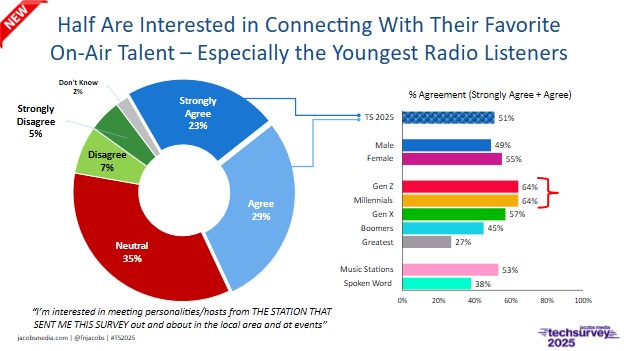
Yesterday’s post, “The Exponential Value of Nurturing Radio Superfans,” made the case for doubling down on core listeners. Throughout the day yesterday, I had a number of conversations with industry colleagues about the efficacy of this strategy.
While I took great pains to make the case that a core fan strategy is not at the exclusion of continuing to go after larger cume numbers, the evolution of broadcast radio combined with its unmanageable competition makes it a necessity to circle the wagons around the core—the folks who’ve brought our radio stations to the dance, still coming back for more on a regular basis.
Between their habitual listening and in the case of both public and Christian stations, their commitment and ability to regularly donate, make them radio’s MVPs.
Christian stations, their commitment and ability to regularly donate, make them radio’s MVPs.
It is also notable those “dance with the one that brung you” is often given out as a piece of sports advice—in other words, keep doing what’s always worked for you.
I’ll add one more layer onto what I have come to believe should be a central part of most stations’ operating philosophy for the foreseeable future: the local piece.
To that point, public radio managers will tell you the “L-word” has become an oft-repeated “yellow brick road” strategy for stations that perhaps have lost their way or are looking to get their mojo back.
Why local? First, it’s the turf radio knows all too well, whether it’s the audience or the advertisers. Second, it’s a much easier competitive environment to navigate. And third, the opportunity is likely growing as large numbers of young people have moved back to their hometowns since the pandemic.
And then there’s the data, clear in most public and commercial radio research I’ve seen or conducted over the past few years. It’s not that people aren’t concerned with what’s transpiring in the country and around the world, it’s that the local environs are more tangible and close. While national and international news events seem like they’re spiraling out of control, there’s a lot to be said for the friendly confines of Main Street.
The trend line for local from our newly-released Techsurvey 2025 makes this case, reinforced by numerous studies in the public radio sector:

The dotted red line is a clear indication the emphasis on local reached a higher plane since the pandemic, a trend we’ve noted in our Public Radio Techsurvey as well.
Beyond the obvious connection with the local turf, however, it is the core audience premise revolving around what I call “Radio’s MVPs” that is so compelling.
And the article I mentioned yesterday from Tech Dirt’s Glyn Moody (republished by our friends at Hypebot) is both thoughtful and compelling.
“Can Superfan platforms solve the musician income crisis?” is clearly written from the perspective of the music industry and platforms such as Patreon and Only Fans. But the applications to radio are unmistakable. Its principles might just be transferable to helping solve radio’s revenue and competitive crises.
One of these tenets is the idea of fans engaging with other fans. That’s right—radio veterans know this tactic as “Tell-A-Friend,” but that concept was born in the era of cart machines and turntables. The Internet supercharges this relationship, making it seamless, efficient, and scalable to grow a local fan base.
 Yesterday’s post triggered the observation below from DMR/Interactive CEO Andrew Curran (pictured) who knows a smart marketing plan when he sees one:
Yesterday’s post triggered the observation below from DMR/Interactive CEO Andrew Curran (pictured) who knows a smart marketing plan when he sees one:
“Fred, you’re speaking DMR/Interactive’s language this morning. While you have been including NPS (Net Promoter Score) for two decades, we’ve been including Tell-A-Friend referral in our contest registrations to grow the station database equally as long. It used to be via reply cards and fax, then email, now it’s by text message, socials and QR codes. Best of all, when a station Super-Fan shares a contest with a friend or co-worker, the acquisition cost is zero. These Audience Amplifiers are worth their weight in gold and we help stations treat them.”
Add to that, Patreon’s business plan, predicated on word-of-mouth growth:
“Core fans are more likely to energize the rest of a creator’s community by engaging with other fans. In doing so, they can help snowball the fandom into a community that generates value on its own, even when the creator is not posting new work…The new driver motivating creators to build a large follower count is to have more chances to turn followers into fans, and fans into core fans.”
That’s one of those rare core principles that both Andy Travis (programming) and Herb Tarlek (sales) can rally around. It is easier to induce a current customer—listener or client—to engage more with a brand than it is trying to entice a non-user.
Another mitigating factor is the empty column in the radio budget where the promotion and marketing used to be. Yes, that will vary by company, brand, and even quarter. But in general, most radio broadcasters lack the resources to launch legitimate campaigns designed to attract new audiences. It’s just another way in which the radio broadcasting industry does not resemble its former self.
It’s also smart to listen to those who have been knighted, specifically Sir Lucian Grainge (pictured), Chairman/CEO of Universal Music Group. Quoted in Walled Culture in 2024, he outlined in his annual note to the entire staff how the company will be engaging with its core fans moving forward:
in his annual note to the entire staff how the company will be engaging with its core fans moving forward:
“In 2025, we’ll also be reaching out in new ways to engage fans. In addition to listening to their favorite artists’ music, fans want to build deeper connections to artists they love. Last year, in accelerating our direct-to-consumer and superfan strategy, we formed a strategic partnership and became an investor in NTWRK and Complex to build a premium live-video shopping platform for superfan culture. This year will see us expanding our product offerings to fans, as we continue to redefine the ‘merch’ category and create superfan collectibles and experiences.”
Interesting Sir Lucian points to merch, another tool from the past that was once an integral part of radio’s growth strategy back in the day. Today, a viable merch strategy requires better fashion sensibility, creativity, message relevance, and a viable production engine. But for already solid brands, merch remains not just a revenue opportunity, but also a marketing and growth tool that has been all but forgotten by today’s radio purveyors.
And then there’s Grainge’s idea of a deeper connection to musicians and bands carries over to radio personalities. In a new question this year in TS 25, we asked our 24-54 respondents whether they’re interested in events and experiences revolving around favorite air personalities.

As I like to say, “your mileage will vary.” That is, the appeal of your personalities, their charisma, and their willingness to engage with fans differs greatly from station to station, so check your research if you’re not sure.
But when I see an average degree of agreement of 51% with even higher numbers among Millennials and Gen Zs, the idea of catering to the needs and desires of “superfans” becomes even more appealing.

via LinkedIn
Moody also points to other familiar music giants going down this same core road, including Warner Music Group, now developing what they are calling a “superfan app.” WMG’s CEO Robert Kyncl (pictured) says the idea is to facilitate “direct-to-superfan experiences.” And he notes these elite fans “are generally the people that consume the most and spend the most.”
Yup, P1s and Net Promoters, to bring it back home to downtown Radioville.
And we can never leave Spotify out of these conversations, because they’re always looking down the road. Not surprisingly, they’re thinking along these same lines, called “superfan clubs.” Their domain for these entities will be the European Union where the passage of the DMA—or Digital Markets Act—now allows Spotify to market directly to its fans without having to pay Apple’s 30% app tax.
App developers like my friends down the hall at jacapps will tell you what a big deal this might be in the EU.
But looking at the larger world of marketing strategies to grow and nurture audiences, Glyn Moody reminds us, “The true fans idea has entered the mainstream now.”
Radio cannot afford to watch from the sidelines. It is time to have a hard and honest conversation about what can work in 2025—and beyond.
Read Part 1 – “The Exponential Value of Nurturing Radio Superfans” here.
Originally published by Jacobs Media









